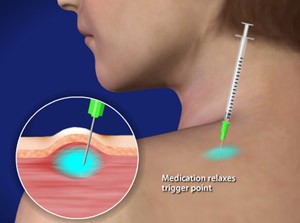
A trigger point injection (TPI) can help relieve myofascial pain, which is usually caused by a “knot” in your muscle (trigger point). TPIs are common and generally safe.
Accordingly, that muscle spasm or tightness that you experience may be a consequence of an underlying ligament injury. Trigger point release can address these chronic irritations that cause pain at night – especially as you sleep on your back or hip. However, if these trigger points continue to come back, you may need further evaluation and treatment.
Trigger point injection therapy (TPI) may be an option for treating pain in some patients. TPI is a procedure used to treat painful areas of muscle that contain trigger points, or knots of muscle that form when muscles do not relax. Many times, such knots can be felt under the skin. Trigger points may irritate the nerves around them, and cause referred pain, or pain that is felt in another part of the body.
Trigger Point Injections Q & A
How do trigger points develop?
When a muscle becomes tired, strained from excessive use, subjected to excessive pressure, or experiences a direct impact, it can develop a specific, concentrated contraction in its smallest functional unit. This contraction can disrupt the blood flow to the affected area. Besides injuries and overuse, trigger points can also develop due to factors like wearing ill-fitting shoes, having irregular posture, experiencing ligament injuries, dehydration, or having issues with joint hypermobility. After effective treatment, trigger points should not reoccur. If they do, it indicates that the underlying cause needs to be addressed.
What happens if they are not treated?
Significantly, trigger points create a shortening of a muscle unit, which causes the force around a joint to be altered. Over time, this abnormal wear pattern may lead to arthritis or other injuries.

What Conditions can Trigger Point Injection Therapy Treat?
Trigger point injection therapy can reduce your pain dramatically. They coexist with other causes of pain and should be identified and treated with any joint pain or arthritis.
- Chronic back pain
- Chronic neck pain
- “Tailbone pain”
- Whiplash injuries
- Running athletes (pulled hamstring)
- Repetitive motion injuries (throwing athletes, typing, factory workers, laborers)
- Some fibromyalgia
How long does it take to notice an improvement?
Stiffness typically manifests within the first 24 hours following the treatment. By the next day, any pain stemming from trigger points should have subsided. Many patients observe an enhancement in their sleep quality on that following night, which aids in distinguishing trigger point-related pain from other sources of discomfort.